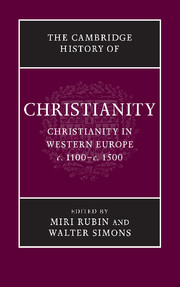Book contents
- Frontmatter
- Introduction
- PART I INSTITUTIONS AND CHANGE: 1100–1200
- PART II FORGING A CHRISTIAN WORLD, 1200–1300
- PART III THE ERECTION OF BOUNDARIES
- PART IV SHAPES OF A CHRISTIAN WORLD
- PART V CHRISTIAN LIFE IN MOVEMENT
- PART VI THE CHALLENGES TO A CHRISTIAN SOCIETY
- PART VII REFORM AND RENEWAL
- 26 Empowerment through reading, writing and example: the Devotio moderna
- 27 Demons and the Christian community
- 28 Wycliffism and Lollardy
- 29 Observant reform in religious orders
- 30 Public purity and discipline: states and religious renewal
- 31 The Bible in the fifteenth century
- Select bibliography
- Index
- Map 1 Western Europe c. 1100 – c. 1500
- Map 2 Universities of Europe
- References
29 - Observant reform in religious orders
from PART VII - REFORM AND RENEWAL
Published online by Cambridge University Press: 28 March 2010
- Frontmatter
- Introduction
- PART I INSTITUTIONS AND CHANGE: 1100–1200
- PART II FORGING A CHRISTIAN WORLD, 1200–1300
- PART III THE ERECTION OF BOUNDARIES
- PART IV SHAPES OF A CHRISTIAN WORLD
- PART V CHRISTIAN LIFE IN MOVEMENT
- PART VI THE CHALLENGES TO A CHRISTIAN SOCIETY
- PART VII REFORM AND RENEWAL
- 26 Empowerment through reading, writing and example: the Devotio moderna
- 27 Demons and the Christian community
- 28 Wycliffism and Lollardy
- 29 Observant reform in religious orders
- 30 Public purity and discipline: states and religious renewal
- 31 The Bible in the fifteenth century
- Select bibliography
- Index
- Map 1 Western Europe c. 1100 – c. 1500
- Map 2 Universities of Europe
- References
Summary
The period of the so-called Observant reforms (c. 1370–1500) was far more dynamic than longstanding convictions concerning the decline of religious life in the closing centuries of the Middle Ages once led us to believe. Amidst papal schisms, conciliary infighting, protracted warfare, echo-epidemics, apocalyptic expectations and heightened fears of popular heresies, many religious orders experienced a veritable renaissance, coupling aims to reclaim pristine traditions with a new pastoral and spiritual acumen. At the same time, new religious movements sprang up, whose vitality struck the imagination of contemporaries.
As the name indicates, the Observance (observantia/observantia regulae) within the orders was first and foremost a movement to return to the rules and the lifestyle of their pristine beginnings. A major motivation for this was the conviction that the orders had succumbed to decadence, by discarding loyalty to their rules, and by giving in to pressures that had allowed them to become wealthy and influential, but through which they had lost much of the spiritual ardour to fulfil the tasks for which they had been created.
For most religious orders, the Observance constituted not the first attempt at reform. In the course of time, the call for reform had sounded repeatedly. Sometimes it had been inaugurated from within, and sometimes it had been imposed from outside, as with the 1335–9 reform statutes for the religious orders issued by Pope Benedict XII.
Keywords
- Type
- Chapter
- Information
- The Cambridge History of Christianity , pp. 446 - 457Publisher: Cambridge University PressPrint publication year: 2009
References
- 7
- Cited by



